Last updated: 25 June 2023
Ok, so if you’re thinking of taking a weekend break in France then you might be looking at visiting Paris, right? And why wouldn’t you when you can walk across the ornate Pont Neuf bridge, explore the interior of the magnificent Notre Dame Cathedral, and gaze lovingly out across the expanse of the city from atop the Eiffel Tower, right? But happens if you’ve done that? Where else should you spend your weekend break?
That’s a great question and if you’re looking to discover a different side of France, somewhere a little less-travelled, slightly less touristy, but still has all the beauty of the quintessential postcard-looking French villages which are steeped in medieval and modern history and which have a deep-rooted culture which stretches back through time, then do we have a weekend itinerary for you…
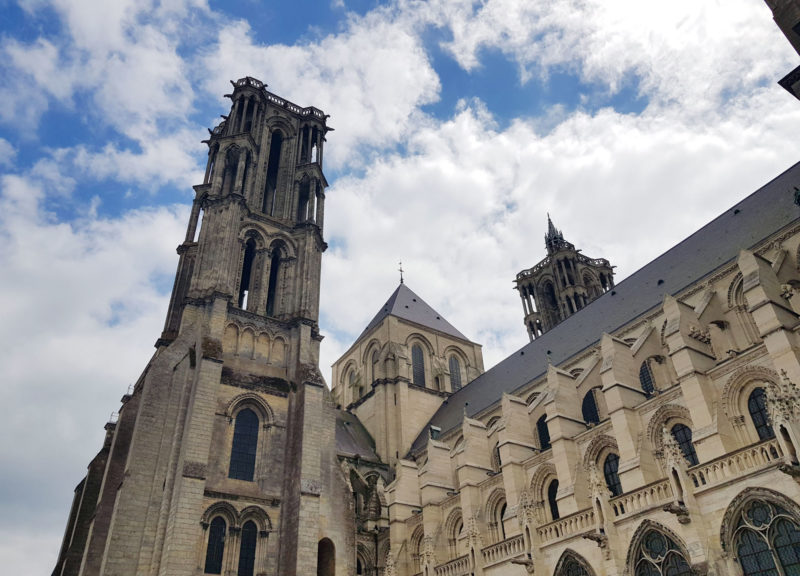
We recently spent a long weekend, driving through through the Aisne region of France and experienced some truly amazing places which really captured our imagination; from World War I battlegrounds and memorials, to sampling some delicious food (yes, there was cheese, of course!), and taking photos of intricate architecture and the natural beauty of the region.
Let us show you what a weekend road trip through the region of Aisne France looks like 🙂
Where is Aisne?
The department of Aisne (department = district/region) is located in the Hauts-de-France region in Northern France, it’s just under a 2 hour drive from Lille or Paris. This means that visitors from London can reach Aisne easily by taking the Eurostar direct to Lille and hiring a car from the station terminal.
A Weekend Break in Aisne France
The following is how we spent our 3 days in the Aisne region visiting the historic city of Saint-Quentin, the medieval walled city of Laon, and the essential Chateau-Thierry. This post will cover what we did, where we went, and where we stayed, so hopefully it will be helpful to you when you plan your weekend road trip.
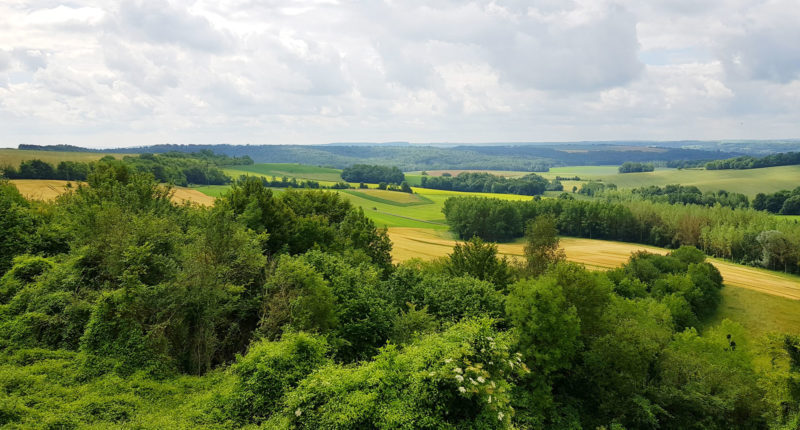
Day 1 – Friday
Getting There
Both Roma and I are big fans of the Eurostar because it can be a very smooth and comfortable way to get from London to France, it feels a little more relaxed than flying (and all the headaches that go along with it at the airport) and the chance of turbulence is practically zero so you can’t complain about that 😉 One tip if you’re leaving London on a Friday, always make sure you leave extra time to get through security and immigration because there are definitely going to be queues!
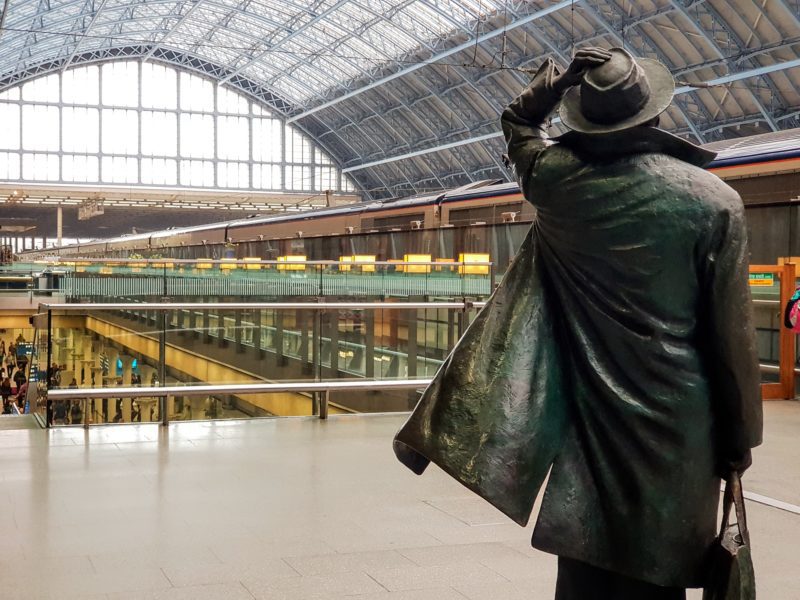
We took an early morning Eurostar out of King’s Cross St Pancras to Lille, total travel time was about 2.5 hours which provided a good amount of time to do some reading, writing, and tweet (when there was signal).
What is the Eurostar?
The Eurostar is a high-speed train connecting London with cities in France, Belgium and The Netherlands. All trains traverse the Channel Tunnel between the United Kingdom and France travelling up to 300 km/h (186 mph).
Hiring a Car
No road trip can begin without collecting our chariot of choice so once we arrived in Lille we headed to the car rental section of the terminal, fortunately it’s only about a 5 min walk from the Arrivals hall. There are plenty of companies to choose from, we booked our car through Sixt and after the standard paperwork we were ready to go.
Before setting off I spent a couple of minutes in the driver’s seat repeating my European matra “Drive on the right, drive on the right, drive on the right” and then hit the open road to our first stop Saint-Quentin.
Saint-Quentin
From the moment we stepped foot into the middle of Saint-Quentin it was like stepping back in time, it was simply beautiful. However, as we soon discovered, there was a violent history which lay beneath its alluring exterior.
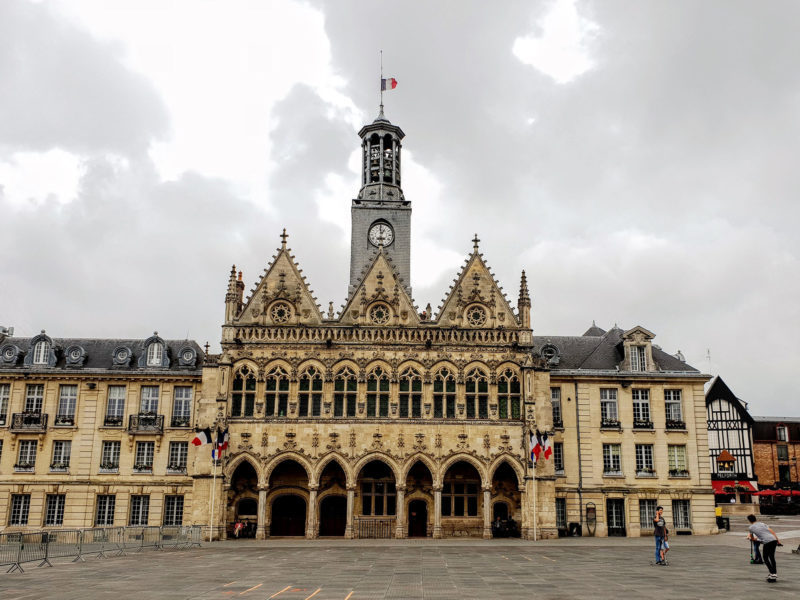
From last August 1914, the town of Saint-Quentin was occupied by the German forces. It was during the 31 month occupation, that the town was pulled deeper into the German war effort by becoming a hospital city with seven military hospitals and over twenty five ambulances in operation. The hospitals were never designed to house long-term patients but rather as a triage unit before sending German soldiers back to Germany. Meanwhile, captured French soldiers were sent to prison camps.
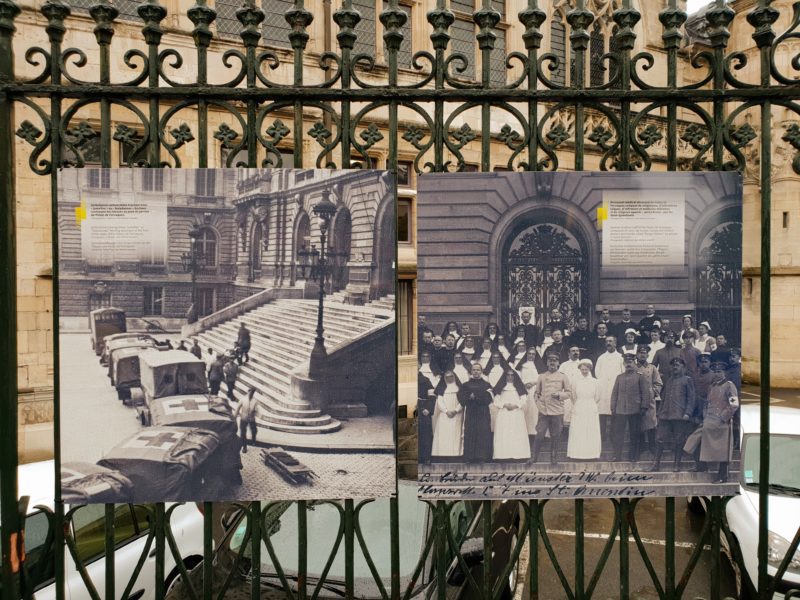
Following the end of World War I, 80% of the entire city had been destroyed and the reconstruction effort took many years to rebuild the city. The rebuilding effort resulted in different architectural styles being used, some rebuilt in an older style in an effort to regain what was once lost whilst others chose a more modern style reflective of the town’s desire to move forward.
We learned that Saint-Quentin is popular with visitors from Belgium, France, and Australia. The town was liberted by the British and French Army at the end of World War I which remains one reason why visitors from around the world spend time in Saint-Quentin, to connect with those who came before them.
We also learned that the Hindenburg Line had been broken at Riqueval thanks to the British, American, and Australian troops. It was this last one which obviously caught our attention, and explains why many Australians visit the area, to actively seek a connection with their ancestors and their heroic efforts.
The City Hall
Saint-Quentin’s City Hall was one of the first things we noticed when we arrived in town and it’s little wonder as it stands proudly in the middle of town, with high arches and magnificent facade drawing admiring glances from locals and visitors alike. The building was completed in 1509 (the interior was rebuilt in 1865) and there are two rooms inside which attract a large number of visitors today, the Marriage Hall and the Council Hall.
The Marriage Hall serves quite a specific purpose and the clue is in its name…yes, that’s right, the people of Saint-Quentin continue to get married in this historic City Hall office, with its original beamed ceiling and huge fireplace. Now, I’m a married man but if I could have a do over then I think this would be the type of place I’d love to get married in, it would be an opportunity to not only marry the woman I love but I could connect with a world of history all at the same time. Doesn’t that sound like my kinda thing?
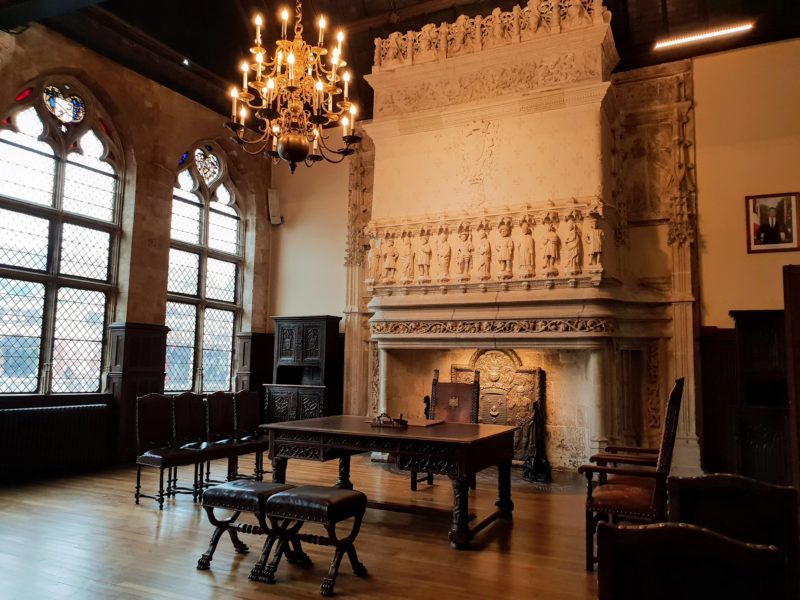
The other room that attracts a lot attention is the Council Hall, rebuilt in 1925, the beautiful Art Deco design can be easily seen in the interior’s gold ornate handrails, heavy iron metalwork, and elegant flower bouquets, it’s a photographer’s delight. It’s a definite Must Visit when exploring Saint-Quentin.
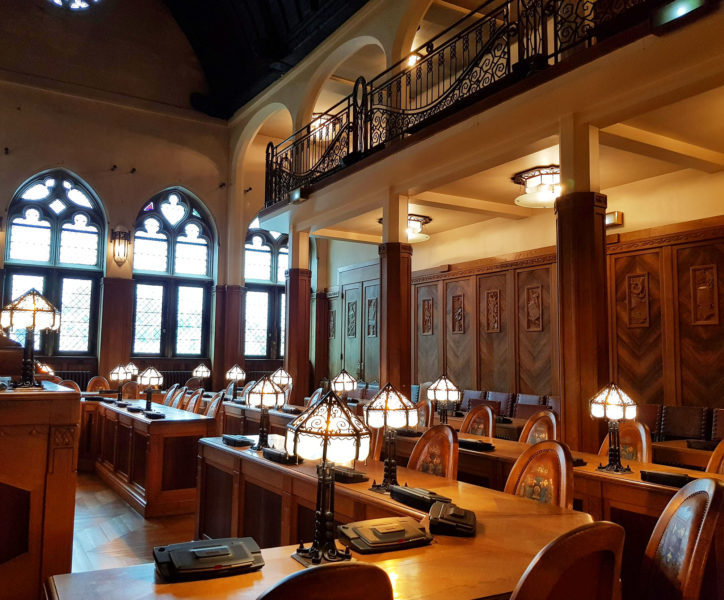
Musee Antoine Lecuyer
As a general statement, I don’t think Roma and I would describe ourselves as art lovers by any stretch of the imagination or people who would spend hours in an art gallery admiring the many works of art…but I think our interests may be changing over time because we absolutely LOVED exploring the Musee Antoine Lecuyer and would go back in a heartbeat 💕
This is not the first time that a visit that we’ve been very pleasantly surprised by visiting a gallery, this first being our visit to the Rodin Museum in Philadelphia. This just might be one of those times when travel changes you, expands your horizons, and shows you a world that you didn’t know existed. And we’re very ok with that 😊
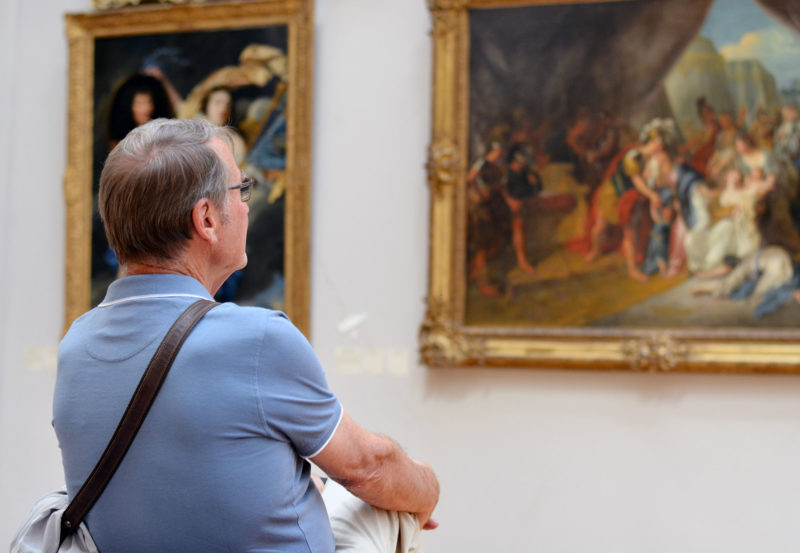
The Musee Antoine Lecuyer is a Saint-Quentin museum is renowned for its collection of pastel portraits by Maurice-Quentin De La Tour, known as the Prince of the Pastellists. It’s interesting to note that pastels were often used for portraits because it took less time than traditional oil paintings. This was due to not needing to mix colours on the palette or to having to wait for paint to dry before applying a second layer of paint. It was for these reasons that the use of pastels for portraits became popular during the 18th century.
You may be wondering why the museum is called the Musee Antoine Lecuyer when the most prized pieces of art are from Maurice-Quentin De La Tour. Good question. The museum is named after Saint-Quentin local banker, Antoine Lecuyer (1793-1878), who bequeathed his private mansion to the city. The works of art by de la Tour were from the artist’s studio and were bequeathed by de la Tour’s brother after the artist passsed away. The museum itself was destroyed during WWI and was completely rebuilt between 1928 and 1931.
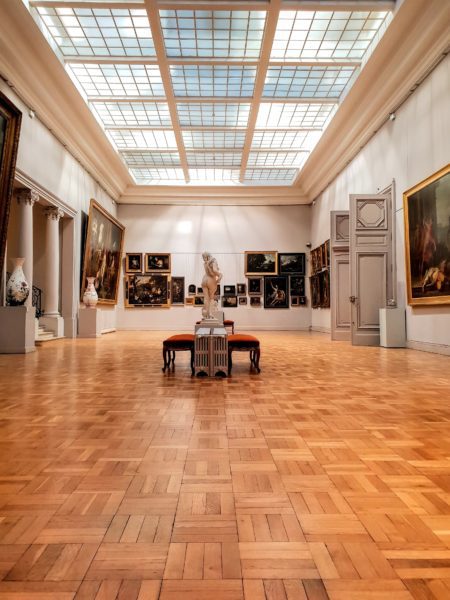
It must be said that as much as we enjoyed the magnificent artwork on display in the Musee Antoine Lecuyer, the absence of signage in English did have an impact on the overall experience. We were informed during our visit that this is something that is currently being looked at and hopefully will be added soon.
Basilica of Saint-Quentin
If you’ve spent any time following us on Instagram or Twitter then you know that we love visiting Cathedrals and Churches and our visit to Saint-Quentin was no exception. Was it worth it stopping by? You better believe it! The Basilica of Saint-Quentin was one of the most incredible places we visited during our first day in the Aisne region.
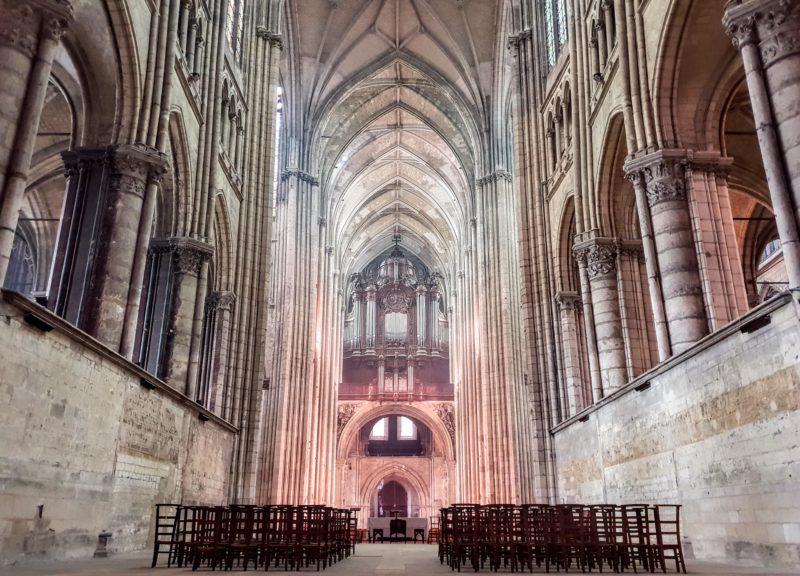
From the moment you walked through the heavy wooden doors of the Basilica of Saint-Quentin, it’s quite obvious that you’re standing in history, it’s really quite awe-inspiring. The location of the present day basilica is the same place where religious building have been built since the 4th century.
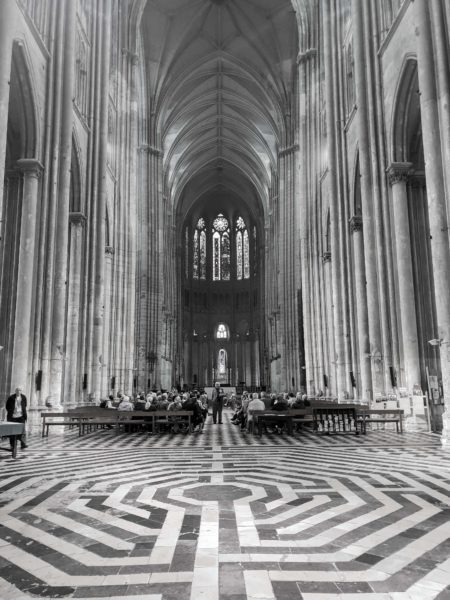
Once you enter and stand at the the Nave looking into the church you will see a large black and white tiled floor which form the design of a maze. This maze is original and dates back to 1495 and was used by pilgrims who travelled to Saint-Quentin and would walk the maze path, all 260 metres, on their knees! After which they would repent and asking for forgiveness for their sins.
Where to Sleep?
After a big first day off seeing the sights of Saint-Quentin, it’s time to hit the road and head to hotel for the night. We stayed at the Hôtel du Golf de l’Ailette in Chamouille, which was about a 60 min drive. Staying at Chamouille was a good choice because it’s close to your first stop in the morning.
Hôtel du Golf de l’Ailette is a four star property with uninterrupted views over Lake l’Ailette. After a long day of travelling and exploring we retired relatively quickly. A bit chilly to dive headfirst into the hotel’s pool that faces the lake, and far too late for a round of golf, instead we settled into a quiet dinner at L’Albatros, the hotel’s inhouse restaurant.
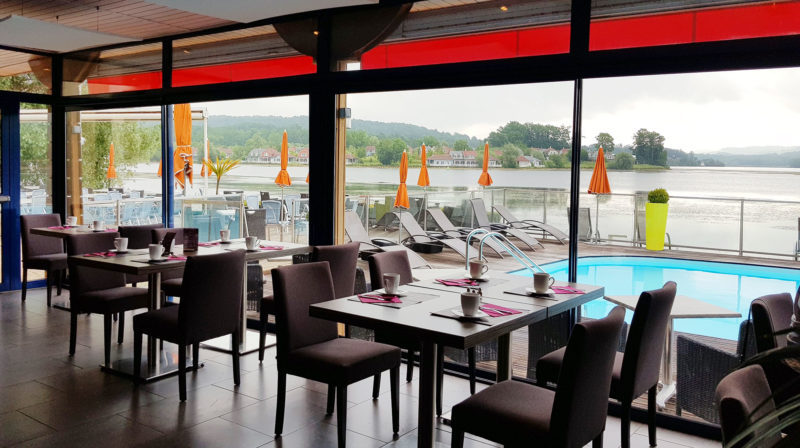
In the morning, our elegant room was lit by the rising sun over the lake, rewarding us with another glimpse of the panoramic view on the Lac de l’Ailette. A quick continental style breakfast with a mix of fruit, fresh pancakes, yoghurt, cured meats, cheese and bread and we were back in the car ready to start day two.
Day 2 – Saturday
Another big of exploring was ahead of us and the first stop of the day was the Caverne du Dragon. In order to appreciate your visit to the Caverne du Dragon, here’s a little background information (just a little, I promise).
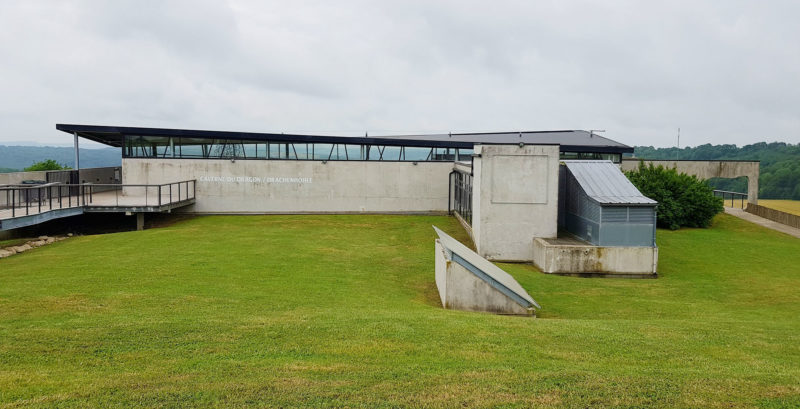
There is a 30km road which runs east and west between the river Aisne and Ailette called The Ladies Road, in honor of Louie XV’s daughters who were said to have crossed this road.
The region was of great strategic importance during the The First World War, and was the scene for three battles; First Battle of the Aisne in 1914, Second Battle of the Aisne in 1917, and the Third Battle of the Aisne in 1918.
And whilst the battles were horrific and countless men gave their lives during fierce fighting, it was what was taking place 50 feet (15 metres) beneath their feet that was all the more incredible.
Caverne du Dragon
Located beneath the battlegrounds were stone quarries which were used for centuries to provide stones for houses, churches, and even safeguarding flocks of sheep. Also it wouldn’t be France without wine, and the cavern made a great cellar, due to the relatively cool temperature of 12 degrees, meaning it was also a perfect place to store wine. However during the war, the large excavated caverns became temporary barracks for the soldiers during the ferocious fighting above ground.
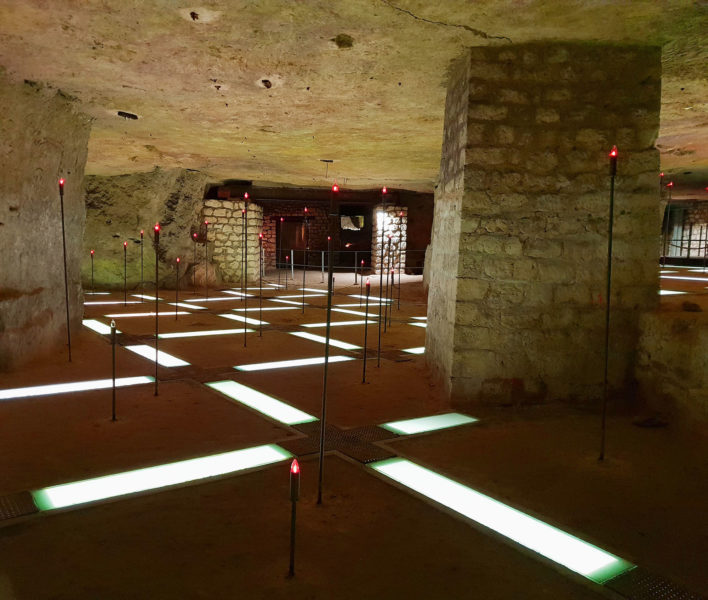
When Roma and I descended underground and stood in silence as we allowed the enormity of the caverns sink in, we were literally standing in history. And not just history belonging to French soldiers, the caverns exchanged hands seven times which meant that we were standing in a place where the echoes of The Great War reverberated beneath our very feet. Honestly, it was hard to comprehend.
As we made our way through the tunnels we were surrounded by the remnants of ammunition, weapons, and uniforms, all of which were recovered by farmers in the area. Unbelievably, over 300 tonnes of unexploded ammunition has been recovered. It’s only when you’re visiting a place which played such an important role during World War I that you begin to comprehend the enormity of the conflict.
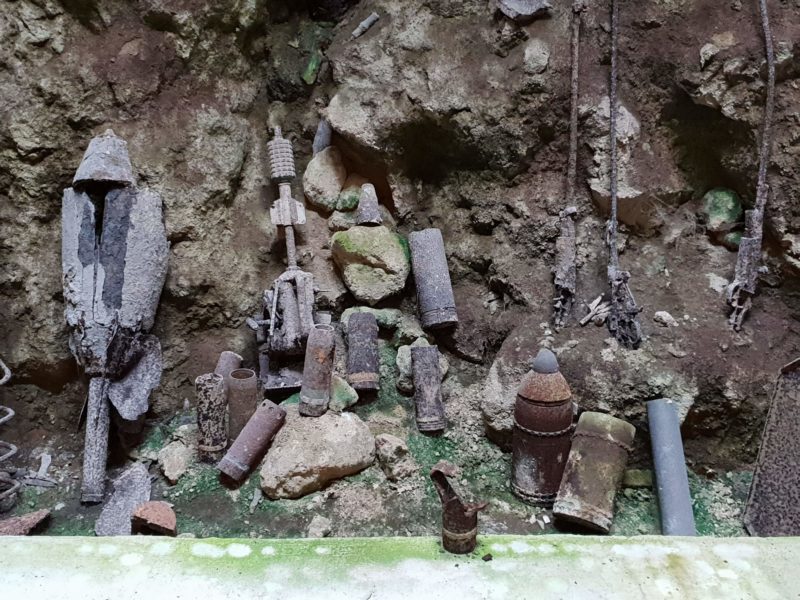
Where did the name Caverne du Dragon come from? It’s been said that it was when the German soldiers saw the smoke coming from the underground kitchen that they referred to the it as the Dragon’s Lair.
Is it worth visiting Caverne du Dragon? I don’t think it’s just worth visiting I believe that you need to visit to truly comprehend the scale of the battles which took place but also an opportunity to connect with those who came before you.
Exploring the Chemin de Dames
If you’re like us then after your visit to Caverne du Dragon you will probably need a little time for quiet reflection before hitting the road again. The visitors centre has a nice outdoor area with seating with view of the battlegrounds as they exist today.
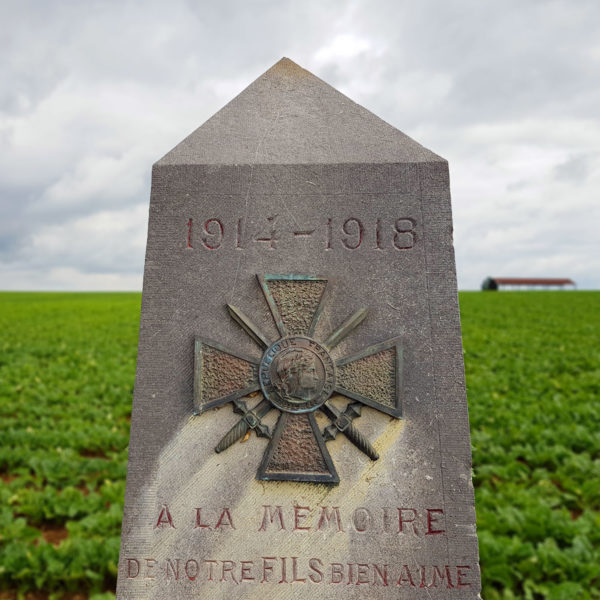
Once you’re ready to hit the road then we suggest taking a drive up visit some of the other memorials along the Chemin des Dames. Now one thing to bear in mind is that there are A LOT of monuments, memorials, and information boards along the drive so keep an eye on the time otherwise you may lose daylight. If you’re not on a schedule then we suggest stopping at them all!
The Medieval Walled City of Laon
Situated on a hill, encircled by over 7 km of original ramparts, the city of Laon (pronounced ‘lon’) feels like it belongs in an episode of Game of Thrones. It’s no wonder Laon captured the imagination of French writer, Victor Hugo. With an air of romanticism about it, cobblestone streets, it’s certainly possible to spend the day walking around aimlessly around Laon and be very happy with what you discover.
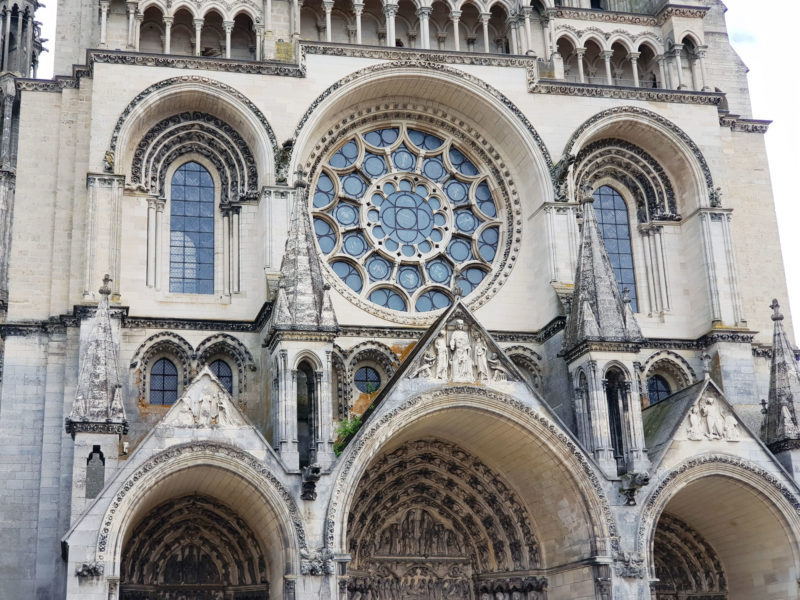
The city of Laon is historically important because it was once the capital of France under the rule of Charlemagne. The city was both politically and religiously important.
Underground Galleries
Our first stop after lunch to meeting our guide, Marie, from the Laon Tourism office to explore the Underground Galleries.
The city of Laon has two parts, the upper town built high on a plateau and the lower town below the ramparts. This means that the houses on the higher parts of the city all have deep underground cellars, some so deep that they extend 4 stories underground, (about 50 metres), and date back to the 17th century! Talk about stepping through time!
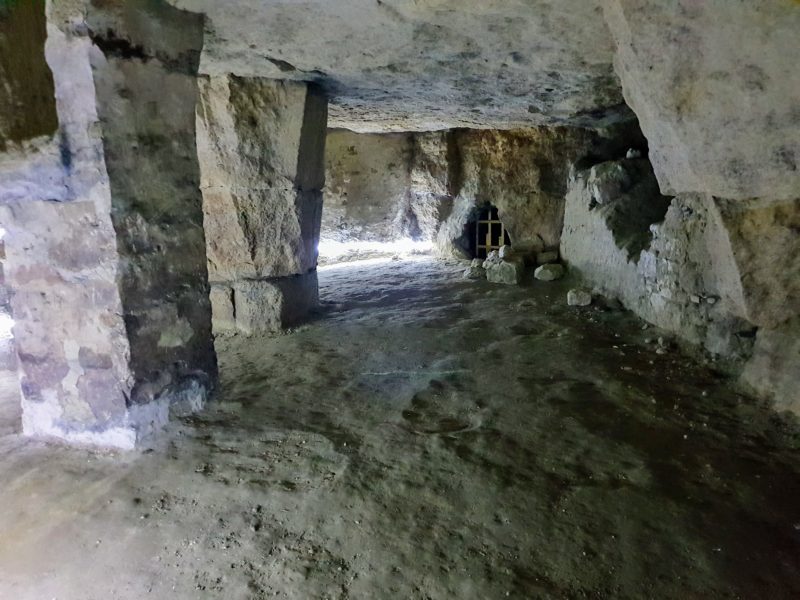
One of the most interesting things we learned was that before 1995, the town’s water supply came from the underground wells in the galleries. Amazing, right?
Laon Cathedral
While driving along the flat Picardy plain toward Laon, like an oasis in the desert, a mound rising a hundred metres above the horizon unveiled itself before our very eyes.
It was Laon Cathedral. With imposing towers, and beautiful Gothic architecture, it was once a major stop on the medieval pilgrimage route to Santiago in Spain, and easily spotted from miles away.
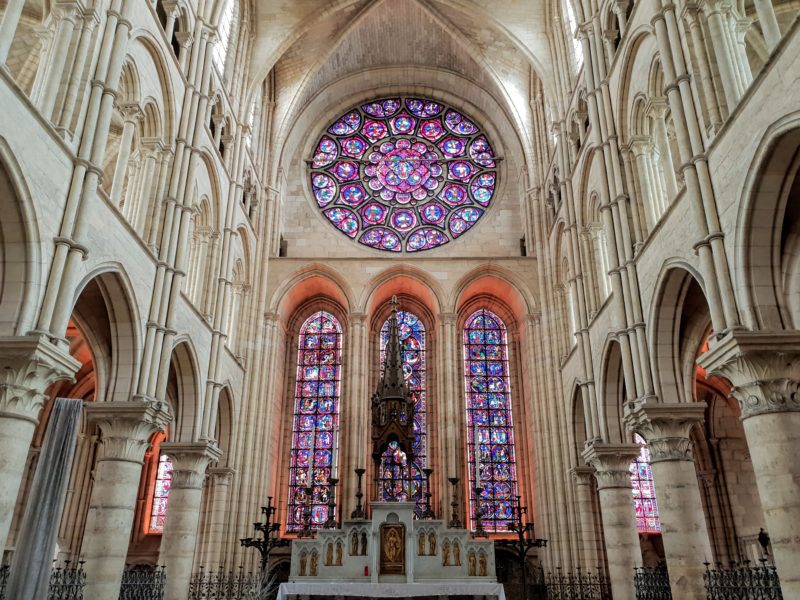
Built between the 12th and 13th century, Laon Cathedral dominates the skyline of the upper town at 110m long and 24m high, it is one of the best examples of Gothic architecture from this period. From afar and even up close it may look similar to the Notre Dame Cathedral in Paris, however Laon Cathedral actually predates it.
We wandered through the nave and choir, we ascended to the tribune to see some gargoyles up close, and wind-worn limestone from the pediment.
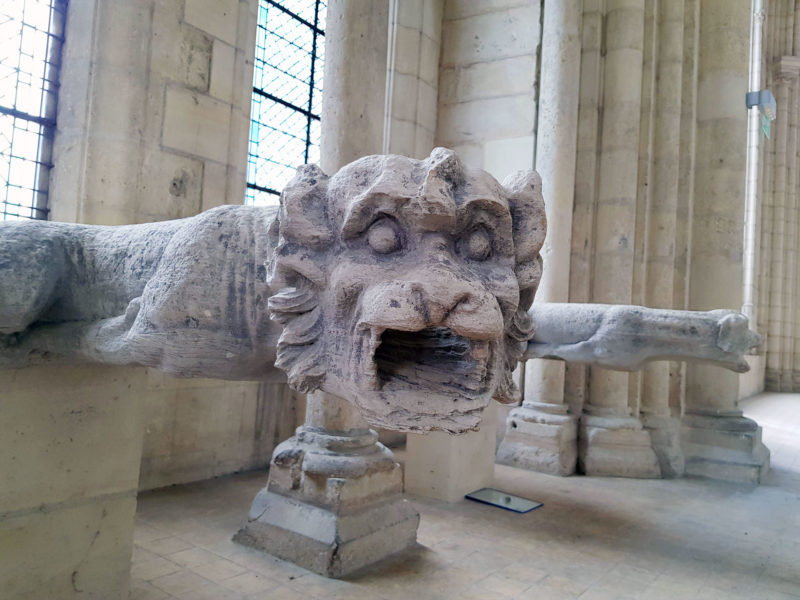
The next bit is not for the faint of heart, we headed to the spiral staircase to begin our climb to the top of the cathedral. The stairs we’re narrow, the climb was steep, tight, and a tad claustrophobic. Roma left her large backpack at the bottom of the stairs, and we’re glad she did. Our reward were the views over upper and lower town Laon, the views were absolutely worth every step.
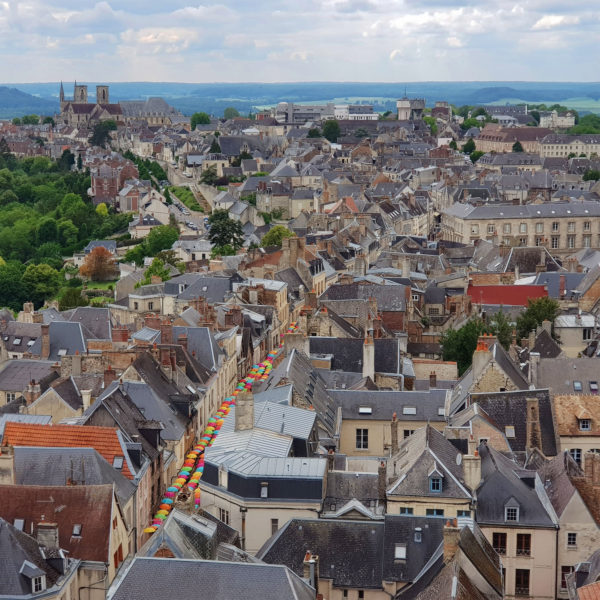
Chapel of the Former Order of the Knights Templar
Once you’ve finished exploring Laon Cathedral and if you’re still in the mood for some more history then just around the corner is the Chapel of the Former Order of the Knights Templar. Whilst it doesn’t look like much from the outside, it’s worthwhile taking a further look inside and discovering this building’s place in history.
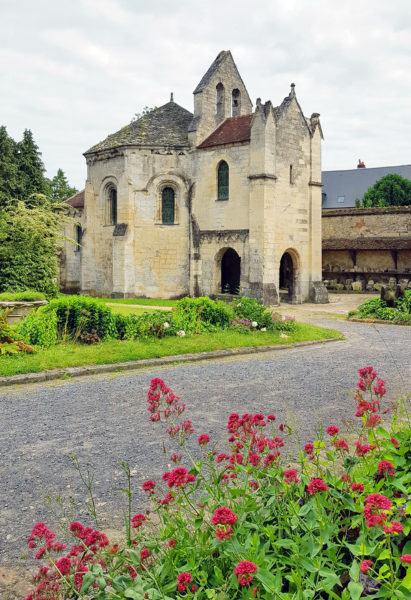
I’m sure that you’ve probably heard the name Knights Templar before, especially if you’ve read The Da Vinci Code or played Assassin’s Creed but who were they really? The Knights Templar (or their full name – The Order of the Poor Knights of Christ and of the Temple of Solomon – you can see why it was abbreviated, right?) was created to protect pilgrims on their way to the Holy Land in Jerusalem. Their role was later expanded to include protection of all holy places.
The Knights Templar were divided into different temples across Europe and the one in Laon was one of the first ones created in 1140 and was modelled after the Church of the Holy Sepulchre in the Holy Land.
Over the years, the temple has been used for a few different purposes – a prison during the French Revolution, a Catholic school, and today part of the Archaeological museum.
Where to eat?
By now your feet are sore and your battery is going flat. Time to stop and recharge the batteries (both yours and your devices). We stopped by Perva for lunch.
Dining out is certainly one way to test your high school French, the menu at Perva is generous to say the least. Fish, mussels and a specific sausage dish seemed to be the most popular dishes. I couldn’t go past a good burger and Roma won’t say no to lamb.
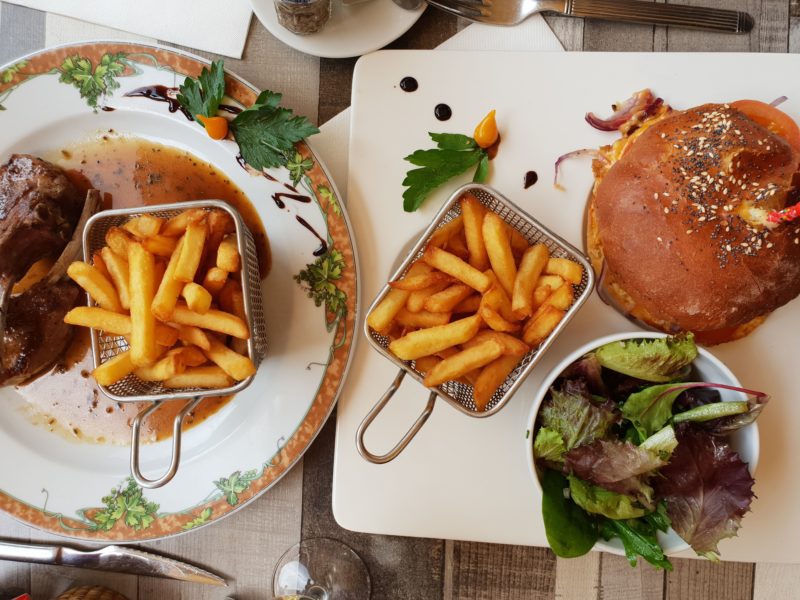
Perva is dog friendly, so much so, staff will bring out a waterbowl to the table for your furry friend.
Where to Sleep?
I am pretty sure that we both let out an audible gasp as we approached the Chateau de Fere hotel, it looked like we were staying in a castle! And you know how much we love a good castle! Located within a majestic forest, Chateau de Fere is a 5 star property, which lies adjacent to the stunning ruins of Chateau de Fere-en-Tardenois, an 800 year old castle!
Chateau de Fere is a part of the Small Luxury Hotels group. A collection of 500 independent small luxury hotels worldwide which offer a variety of unforgettable experiences, selected for their style, service and sophistication.
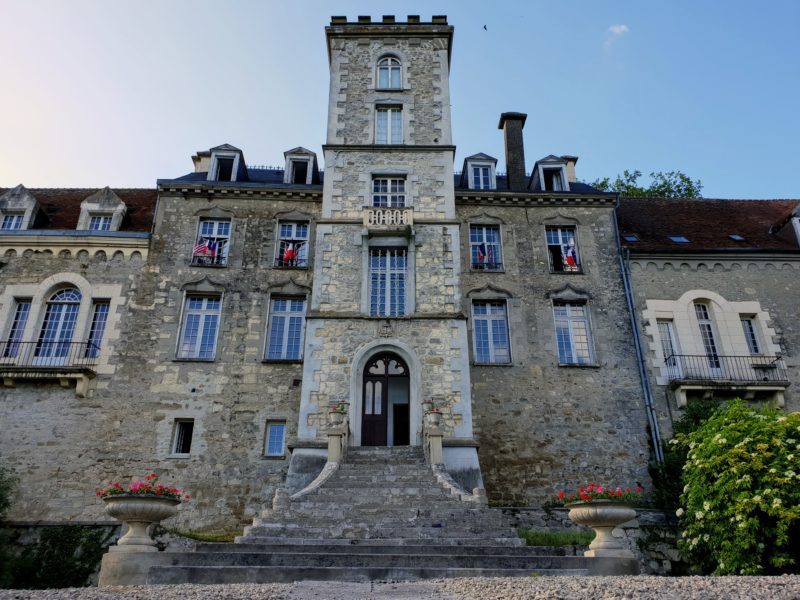
Our first task after checking in was to drop our bags and immediately head for the castle ruins. The late afternoon sun made the ruins glow, it felt incredible to have the whole place to ourselves and reflect on the history which surrounded us and also squeeze in time for a quick selfie too.
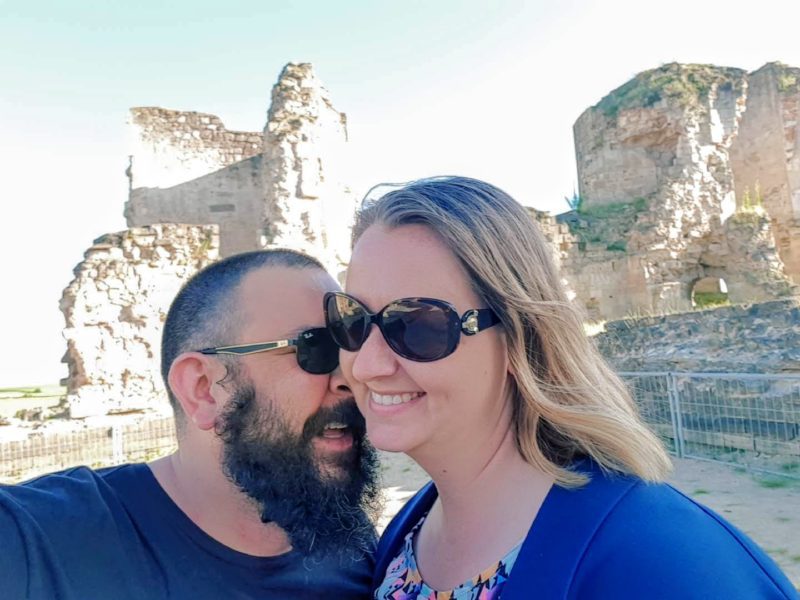
Chateau de Fere provides a relaxing quiet getaway and a French gastronomic focus. So it’s not surprising that we dined in house for dinner.
The start of our three course dinner was foie gras. Fois gras and pate are some of my go-to’s on any menu, so I was pleased to see it appear at Chateau de Fere. Roma paired her starter of foie gras with mango chutney with a sweet moscato wine as recommended by the sommelier.
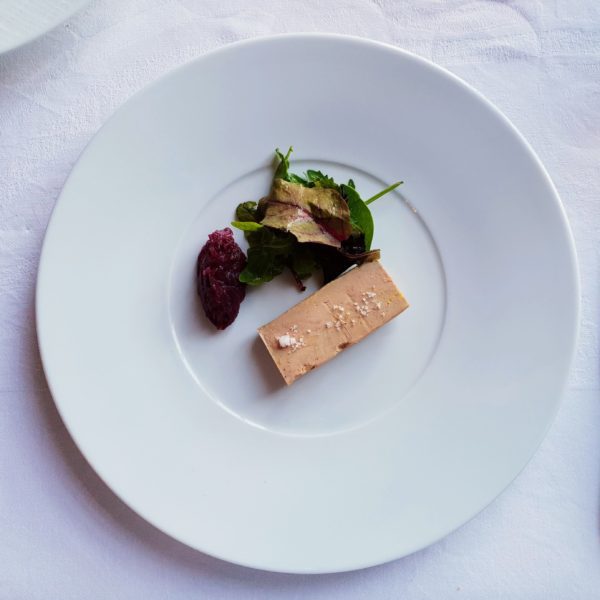
I’ve never seen Roma’s eyes light up as they did when the bread basket came. I know, I know, it’s just bread. But to Roma, it’s not just bread. It’s in baked in house with love and care and served with hand-churned premium salted butter. That’s how you win a woman, lads. With bread.
Out came the mains. Continuing my poultry theme, the duck breast with saffron and mushroom risotto, while Roma opted for sesame coated John Dory fillets.
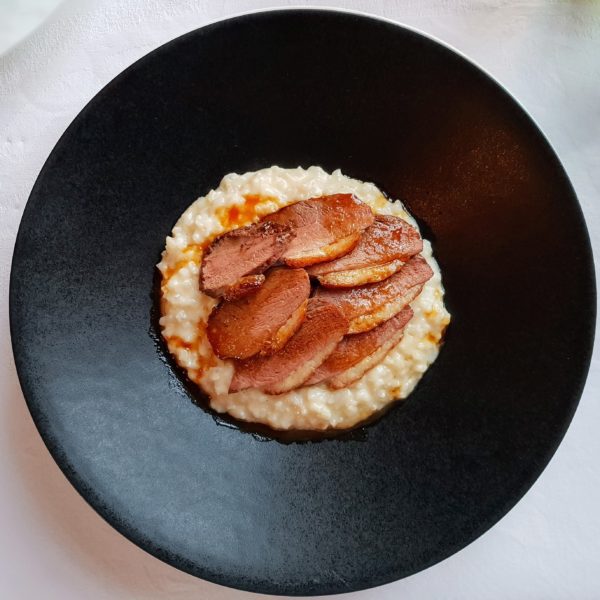
The best is always left to last, dessert. Or in Roma’s case, cheese. An incredibly rich decadent chocolate fondant while Roma was as happy as I’ve seen her in years choosing cheese from the cheese tray; a goats cheese, her favourite French cheese Comte, a soft, a hard and a creamy blue with an array of crackers kept her content for hours.
Breakfast is at Chateau de Fere is a self serve continental buffet with a few hot alternatives. Gorgeous fresh berries, yoghurt, local cheese, cured meats hams and huge range of pastries. For us coffee connoisseurs, we didn’t find the filter coffee up to scratch for a 5 star hotel and would expect espresso to be available. Service was swift but an obvious language barrier between non-French speaking guests and staff proved a challenge.
Day 3 – Sunday
Time to hit the ground running, once you’re packed up, it’s time to hit the road and head to the first stop of the day; Aisne-Marne American Cemetery and Memorial.
Aisne-Marne Cemetery and Memorial
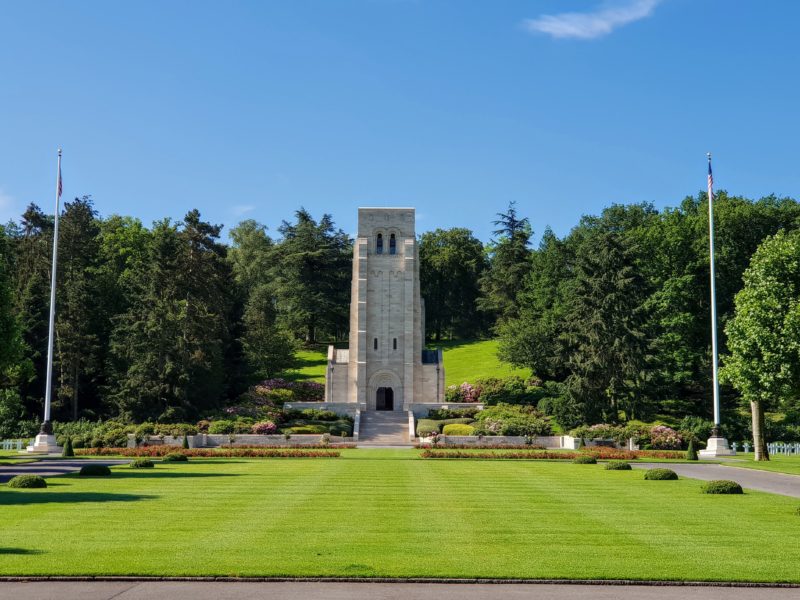
In what was one of the most moving days of the entire weekend break in Aisne, our visit to the Aisne-Marne American Cemetery and Memorial was truly special because it not only gave us a comprehensive understanding of the World War I battles which took place in the area but also highlighted the American involvement, something which seems to get overshadowed by their role in WWII.
A Brief Timeline
To understand the importance of your visit to Aisne-Marne cemetery, here’s a brief overview of the American involvement during World War I;
- 6 April 1917. America joined the war. There were multiple reasons why America decided to join the war, one of the reasons was the sinking of passenger boats (such as the Lusitania) by German U-boats in the North Atlantic. However, another reason was the interception of a telegram sent from Germany to Mexico proposing an alliance to launch attacks on the US.
- The American involvement in World War I was slow at first with only a few hundred soldiers deployed. This increased to thousands and by the end of the war there were 2 million Americans deployed. It is fair to say that it was the American involvement in World War I which changed the face of the war.
- May 1918, the German Empire began their Spring Offensive, a series of attacks to push forward and crush the Allies before the full weight of the American military could be fully deployed. In Aisne, the goal for the Germans was to capture the Chemin des Dames ridge and head south to seize Paris.
- 27 May 1918. German offensive began, later known as the Third Battle of the Aisne, as they pushed south. Three days later, the Germans arrived in Chateau-Thierry, about 10 min drive from the Aisne-Marne cemetery. It was the deployment of two divisions, each containing 25,000 men, which turned the tide of the battle and would eventually halt the German advance. Some of the fiercest fighting took place during the Battle of Belleau Wood, which involved the US Marines. This battle has become part of US Marine folklore and it remains an important part of history between America and France, as evidenced when French President Emmanuel Macron gave an oak sapling taken from Belleau Wood to the United States as part of a state visit in 2018.
- July 1918. Over the course of July, the Allies pushed forward for five months to recapture grounds which had been taken by the Germans in just three days.
Exploring the Aisne-Marne Cemetery
The atmosphere of Aisne-Marne cemetery was one of utter tranquility. About as peaceful as it could possibly get, coupled with the fact that it was a warm June day, the placidity stood in stark contrast to the violent tragedy that occurred during 1918.
There are 2289 men buried at the Aisne-Marne cemetery, the seemingly never-ending rows of white marble crosses echoed their sacrifice during The Great War. The men are not buried by rank or division because as it was in life, they fought together and now they rest together. Latin crosses are used by the American military, a universal symbol for all religions, except Jewish soldiers who have a headstone in the shape of the Star of David.
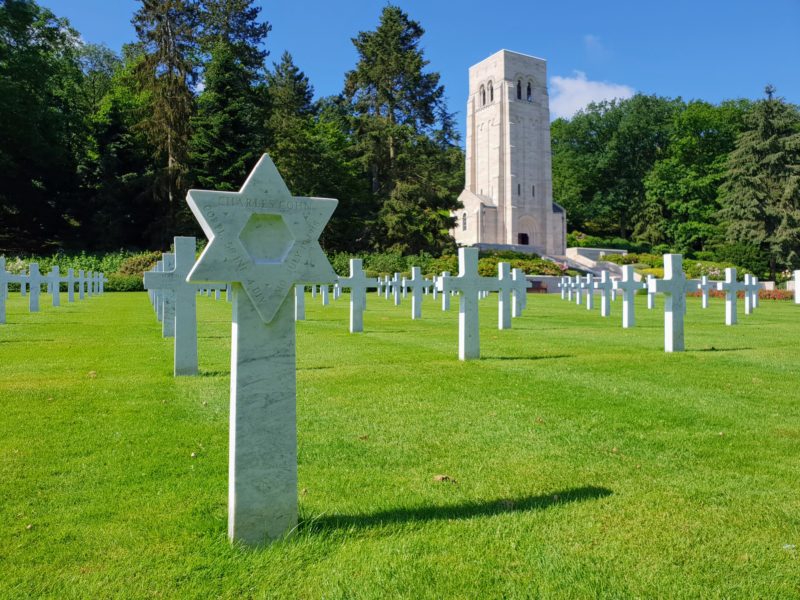
There are 150 unknown soldiers resting here. The search for their identity is ongoing even today. In the event an unknown soldier is formally identified, their body is exhumed and, if requested, repatriated to their family. After which a rosette would be added to the headstone.
One question is asked often is if the lawn is real and we can confirm that it is and is the result of the hard work of 12 full time gardeners who maintain the cemetery, Belleau Wood, and the Chateau-Thierry Monument.
Located at the back centre of the cemetery is the Memorial Chapel, a small chapel which contains the names of all the men who have been classified by Missing in Action. There is a small glimmer of hope in the massive number of names which adorn the walls, 7 names are marked with a rosette indicating that they have been found. Proof of the tireless work undertaken by the team at the American Battle Monuments Commission.
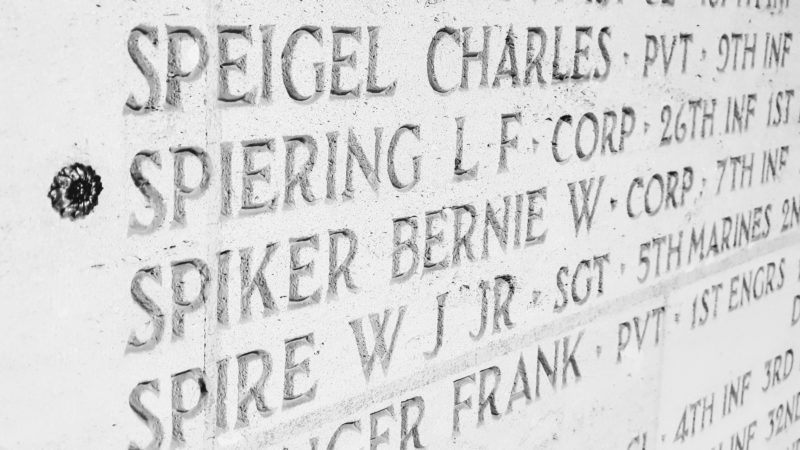
Belleau Wood Memorial
Once you have spent some time reflecting on the great sacrifice of the many men laid to rest in the cemetery, we recommend taking a short 10 min drive to the Belleau Wood. There is a main road which will take you through the woods and there is plenty of designated parking at points which allows you to leave your car and go for a walk. Along your stroll you will encounter bronze plaques, maps indicating where the battle took place, and original German cannons which have been restored and stand proudly as a reminder of the importance of the site.
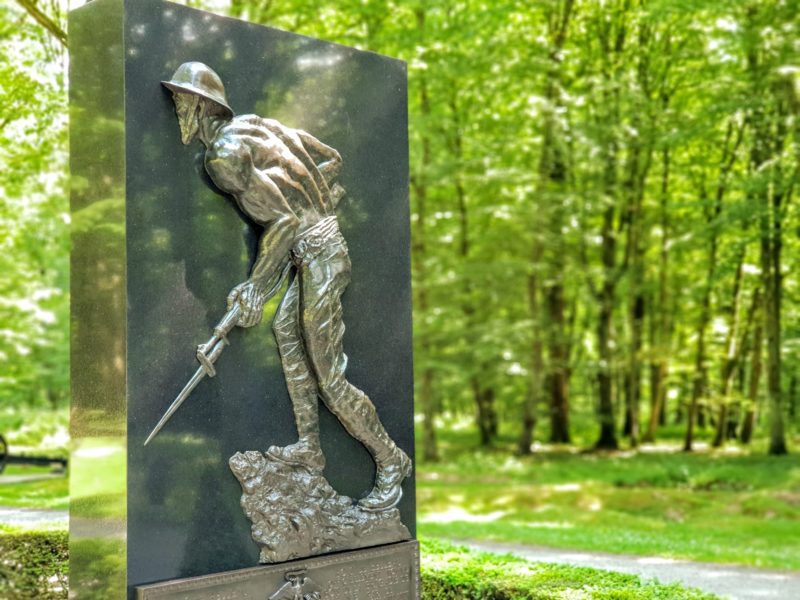
The Belleau Wood memorial consists of a flagpole and monument, depicting a faceless shirtless marine ascending through the woods on his path towards victory. The monument was designed to commemorating the bravery and valour of the U.S Marines who captured Belleau Wood in 1918. As mentioned previously, this particular battle is now part of U.S Marine folklore as it was the first time that America actively engaged in World War I and it took a full 20 days for the woods to be captured, today you can walk the entire ground in 2 hours.
Whilst the memorial and information boards were informative, I think the thing which really captured my attention was seeing original fox holes and trenches. These were actually used by the young men both Allied and German forces. 100 years on, the trenches aren’t as deep as they once were, also given that soldiers weren’t expecting to be fighting in the woods for long, the fox holes probably weren’t much deeper than they are today.
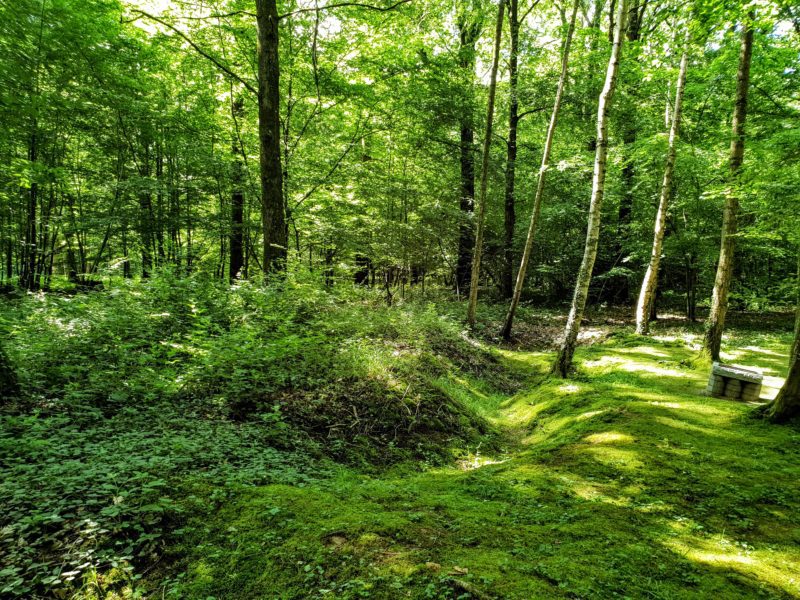
There was something haunting about standing there in silence staring at a hole in the ground and trying to imagine that this time 100 years ago it must have been hell on earth.
Chateau-Thierry American Monument and Visitor Centre
The colossal Chateau-Thierry American Monument is located a short 12 min drive from Belleau Wood so it should be your next stop. If you have to ask is this right? are we in the right place? then you probably haven’t arrived because the monument is absolutely immense!
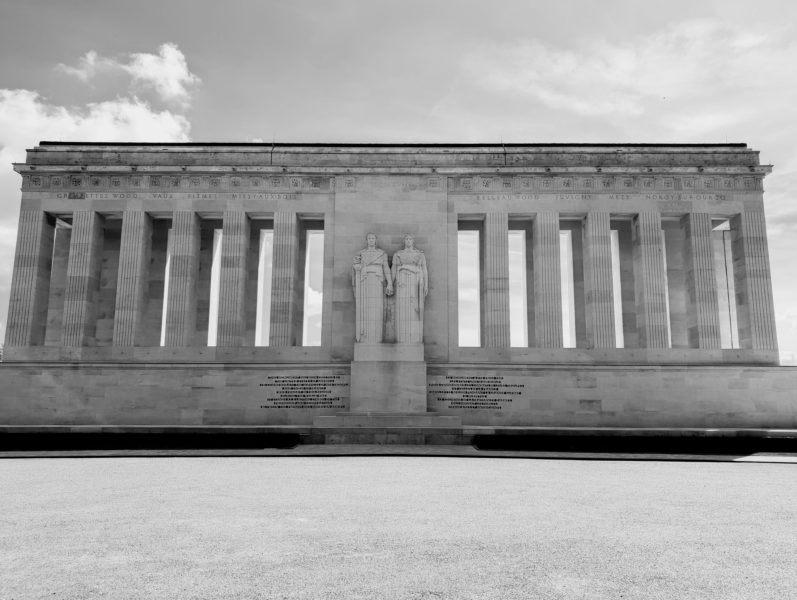
The memorial was started in 1931 and completed in 1933, designed by Paul Cret, and stands as an everlasting monument to the heroic efforts and ultimate sacrifices given by American and French forces during the many Aisne-Marne and Oise-Aisne conflicts.
On one side of the monument, the one you see when you first arrive, shows two immense heroic figures, Columbia (with the sword) representing the United States, and Marianne (with the shield) representing France. On the other side of the monument, overlooking the valley of the Marne River, is a map which details American-fought battle sites and details.
The newly opened Visitor Centre is located inside, beneath the base of the monument and is well worth visiting. Free to visit and with plenty of detailed exhibits designed to provide education and inform all visitors of the role America played during The Great War.
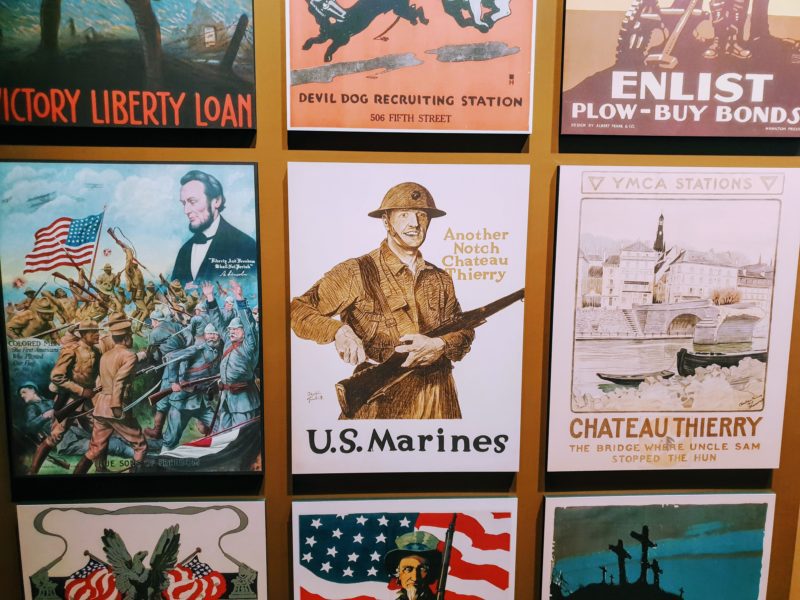
It’s obvious that much time and effort went into the design and construction of the new visitor centre and it’s little wonder that Roma and I wanted to spend hours reading every piece of information available. In typical fashion, right 😉
Champagne Daniel Gerbaux
Now after spending most of the day walking through history and reflecting on all those who came before you, some of you may feel that you need a little change of pace for the afternoon,and if so, then a visit to Champagne Daniel Gerbaux may be in order.
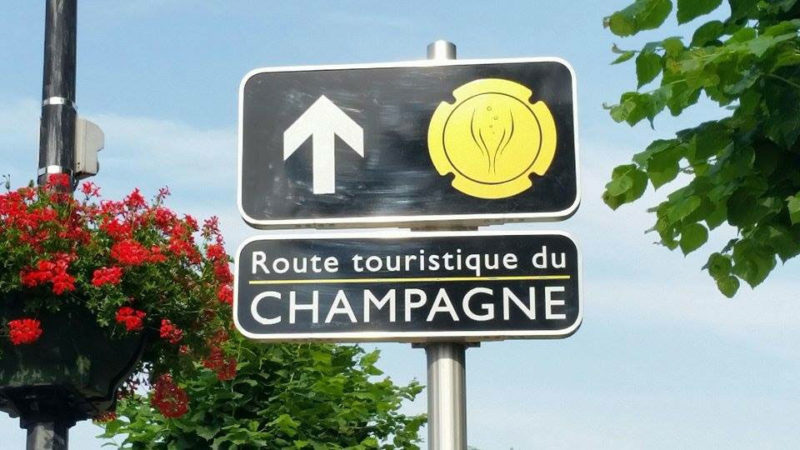
It’s all about quality at Champagne Daniel Gerbaux and there’s little wonder why with 3 generations of the Gerbaux family dedicating themselves to making a consistently superior wine. This is part of a tradition which began with Robert Gerbaux when he founded the vineyard in 1901, continued with his son Daniel, and continues today with Daniel’s son Romain.
We had Champagne Daniel Gerbaux on our To Visit List however we ran out of time so when you visit then please let us know about your experience.
Final Thoughts
If you’ve made it this far then I think it’s fair to say that a weekend break in Aisne France might be on your To Travel List, right? If so, you’re absolutely going to love it because you’re going to discover a less-travelled side of France, somewhere with a rich history and deep culture and somewhere which has played an important role in the lives of so many.
Go visit, you won’t regret it.
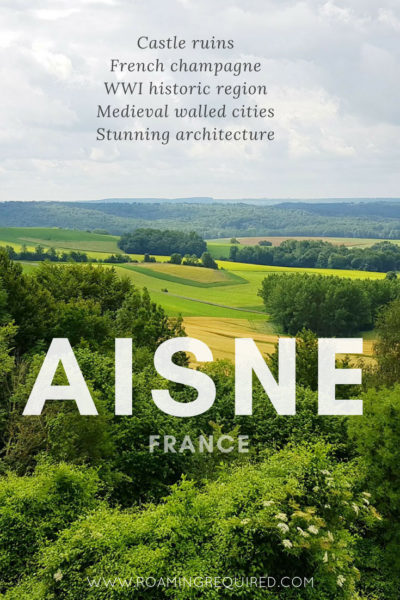
Such a great in-depth city guide! Seems like a perfect weekend break from the UK!
Thanks Nienke, we hope you make it to Aisne soon.
This looks so beautiful – and so relaxing!
A great weekend getaway
Wow, what an informative guide! I’ve actually never heard of Aisne before but it looks beautiful and a great contrast to Paris. I think my favourite thing would be that view – it looks breathtaking. I think I need to remember the existence of the Eurostar more often! x
Laura // Middle of Adventure
I love this. I’ve done Paris and want something more local, a place that has plenty to do but not out of reach. This sounds like it fits the bill! Of course, the wine aspect doesn’t hurt 🙂
Love the amount of detail in this guide, it’s so helpful 🙂 My first stop would definitely be to the top of the cathedral. Everywhere I go I need to climb the tallest structure haha
After our visit to Amiens and around the Somme region of France earlier this year, this is definitely one to add to our list.
I’ve seen Saint-Quentin so often on the roads signs, as we are heading to or from somewhere else in France. However, I’m really tempted, as we love our history, I’m amazed we have visited before. It’s so important to visit these places and to remember, how lucky we are.
And a Knights Templar church in Laon – I’m sold
Wow… u guys can pack a weekend! Have put the Musee Antoine Lecuyer on the list… risotto is a close second!
ps.s. Enjoyed the Warsaw read as well… might have to move back to the UK😬.
Thanks Perry, we certainly do pack in a lot into a weekend. It’s not the pace of travel we’d like to travel at but it’s the pace we have to travel at to see all the things we want to see! Such is the life of a part-time traveller I suppose!
Loved your post on Moscow, it’s been on our list for AGES!